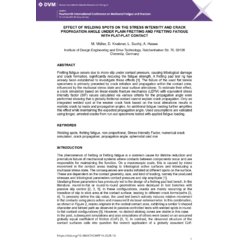- Nur online erhältlich



The failure mechanisms in fretting fatigue are due to micro slip movement under contact pressure. This causes characteristic tribological damage to the surface, resulting in cracks, which can lead to a significant reduction in the fatigue strength of components in contact compared to plain fatigue. To investigate the effect on the strength and crack initiation and propagation mechanisms, the use of a fretting pad test rig as a laboratory model has already been established, in which actively controlled slip and contact pressure can be set independently of the external bulk load. The failure of the flat tensile specimen is primarily preceded by crack formation and propagation from the inside of the contact surface (Fig. 1), influenced by the multiaxial stress state, which implies a…

Datenschutzbedingungen (bearbeiten im Modul "Kundenvorteile")

Lieferbedingungen (bearbeiten im Modul "Kundenvorteile")

Rücksendebedingungen (bearbeiten im Modul "Kundenvorteile")
The failure mechanisms in fretting fatigue are due to micro slip movement under contact pressure. This causes characteristic tribological damage to the surface, resulting in cracks, which can lead to a significant reduction in the fatigue strength of components in contact compared to plain fatigue. To investigate the effect on the strength and crack initiation and propagation mechanisms, the use of a fretting pad test rig as a laboratory model has already been established, in which actively controlled slip and contact pressure can be set independently of the external bulk load. The failure of the flat tensile specimen is primarily preceded by crack formation and propagation from the inside of the contact surface (Fig. 1), influenced by the multiaxial stress state, which implies a tribologically induced failure. The simulative model structure and frictional contact in previous research projects [1] and also in the literature [2] is primarily based on a Coulomb friction contact with a global coefficient of friction. In the experimental tests, however, areas close to the crack initiation sites were also found that could be interpreted as welding spots.
The subject of the investigation is now to perform a simulative comparison of the integrated contact conditions and their effects on the progress of a crack. The basis for this is given within the field of fracture mechanics by the two-threshold model according to Vasudevan et al. [3] combined with a statically introduced crack observed in experiments (Fig. 2) and the integration of the elastic-plastic material behaviour of the experimental reference material spheroidal cast iron GJS-700. Due to the non-proportional loading conditions and multiaxial stresses, an extended criterion for evaluating the equivalent stress intensity factor is applied using crack propagation angles calculated according to Hourlier et al. [4] and Giner et al. [5] comparatively after investigating several other criteria. With these simulative boundary conditions, the previously assumed global coefficient of friction in the Coulomb friction model only shows a sufficiently high stress intensity factor for propagation when the chosen coefficient of friction is above the range revealed by friction tests. In contrast, the introduced locally welded area on the weaker crack flank close to the crack initiation position leads on the one hand to a crack propagation angle that is quantitatively comparable with experimental data and on the other hand indicates crack propagation according to the two-threshold concept. Furthermore, with an additionally integrated bulk force, the crack tip stresses are increased while maintaining the correct crack propagation angle. This setup applied on a longer crack like it was found in run-out specimens leads to smaller crack tip loading indicating crack arrest as it is proven with the run-out samples. Thus, it is simulatively proven that local welding spots can cause and enhance crack growth for short cracks under fretting fatigue and plain fretting conditions, reflected by higher ∆Keq and Keq,max values. In addition, despite the integrated welding spots, crack arrest is indicated under pure fretting and fretting fatigue loading for longer cracks.